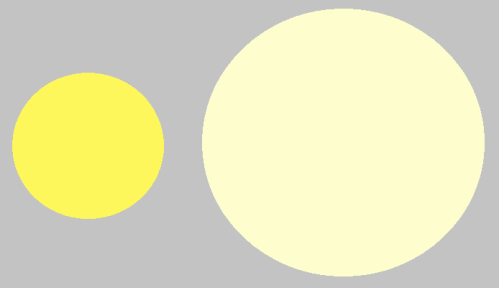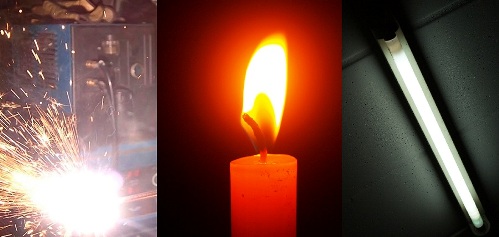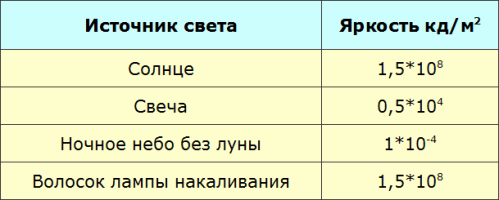Categories: Featured Articles » Sources of light
Number of views: 9221
Comments on the article: 0
What is the brightness of a light source and the brightness of a reflective surface
 To calculate the illumination of various surfaces, it is sometimes very convenient to consider light sources as point sources. But in reality, there are no point sources of light, they always have some specific size and their own shape. A lamp, a chandelier, a floor lamp, a searchlight, etc. are real, that is, not point sources of light that cannot be characterized only by the power of light.
To calculate the illumination of various surfaces, it is sometimes very convenient to consider light sources as point sources. But in reality, there are no point sources of light, they always have some specific size and their own shape. A lamp, a chandelier, a floor lamp, a searchlight, etc. are real, that is, not point sources of light that cannot be characterized only by the power of light.
If, for example, we consider a luminous ball located in the distance, and compare it with another luminous ball, with exactly the same intensity of light, but of a different diameter, it turns out that although the balls create the same illumination at equal distances, nevertheless for the observer they they look different: a ball of a smaller diameter looks brighter than a larger ball.

The reason for this phenomenon is that although the luminous intensity of the balls is the same, one of them has a larger radiating surface, and the other has a smaller one. This means that the power of light emitted from a unit area is not the same for these sources, and this parameter is obviously larger for a small ball.
But even if we begin to consider some kind of light source from a certain distance, then for us it will matter not so much the actual area of the light emitting surface as the visible area, that is, its size in projection onto the observation plane perpendicular to the direction of our gaze.
Thus, in order for an observer to fully characterize a real light source having dimensions and shape, he needs to know both the light intensity of the source and the magnitude of the light intensity per unit area of the visible surface of the source.
This ratio is called the brightness L of the source of the set, and if the light intensity is equal to I, and the visible area is equal to s, then the brightness of the light source will be equal (the light intensity can be described here through the light flux and solid angle, then the brightness will be equal to the light flux emitted from unit area of the visible surface of the light source inside a unit solid angle):

In light sources, the brightness of their different sections is different: in a fluorescent lamp, the edges of the bulb are darker, and the candle flame is brighter in the halo around the wick, etc. The brightness also strongly depends on which side we are looking at the source.
If, for example, you look at the welding arc by chance, then in the direction perpendicular to the discharge it will turn out to be brighter than when looking at the same arc from the side. That is, brightness characterizes the surface emitting light in a selected, strictly defined direction. This is a very important characteristic, because it is our brightness that responds to brightness (luminous intensity per unit area), and not to luminous intensity per se.

The luminous intensity is measured in candela, respectively the brightness - in candela per square meter. One candela per square meter is such brightness that a luminous plane possesses, giving out light from each square meter with a force of 1 candela (Cd) in the direction perpendicular to the plane. For example, here are the approximate brightnesses of some common light sources:

By acting on our eyes, light sources can be dangerous. If the brightness is above 160,000 candelas per square meter, it will cause pain in the eye. To avoid the harmful effects of bright light, mankind has learned various tricks.
The bulbs of powerful incandescent lamps are made opaque and large in size, in order to scatter the light, to make it emitted not from a small area of the filament, but from a large surface area of the bulb or shade. So the brightness is reduced to safe for the eyes, and the illumination remains almost completely unchanged.
If we talk about reflective surfaces, such as painted walls, projection screens, decorative products, etc., they exhibit diffuse reflective properties with respect to the light source. This means that they partially reflect the light incident on them, and now they themselves act as light sources of medium brightness, but of a vast area.

This plays into our hands, since standard light sources (lamp, lamp, candle, chandelier, lantern) have significant brightness, but a small surface area. Meanwhile, the illuminated surface will have a brightness proportional to its light exposure E, because the greater the luminous flux on the reflecting surface falls, the higher will be its brightness.
And the brightness of this surface will be proportional to its albedo r (from lat. Albus - white) - the characteristic of the diffuse reflectivity of the surface. The greater the albedo r, that is, the greater part of the incident light flux scattered by the surface, the greater the brightness of such a surface.

So, the brightness of the illuminated surface is proportional to the product of albedo and illumination, and in different directions the brightness will be different - depending on the scattering pattern of the illuminated surface.
If the surface evenly scatters the light incident on it, then the brightness in any direction is calculated quite simply. If the scattering diagram is complex, calculating the brightness will turn into a rather complicated task.
For uniform scattering it is enough to use the formula (illumination - in lux, brightness - candelas per square meter):

Suppose there is a projection screen with an albedo of 0.8, and the illumination is 60 Lux, then the brightness will be 0.8 * 60 / 3.14 = 15.3 candela per square meter. Here are examples of very common surfaces and their brightness:

See also with us:
Types of electric lamps - which are better and what is the difference
See also at bgv.electricianexp.com
:
